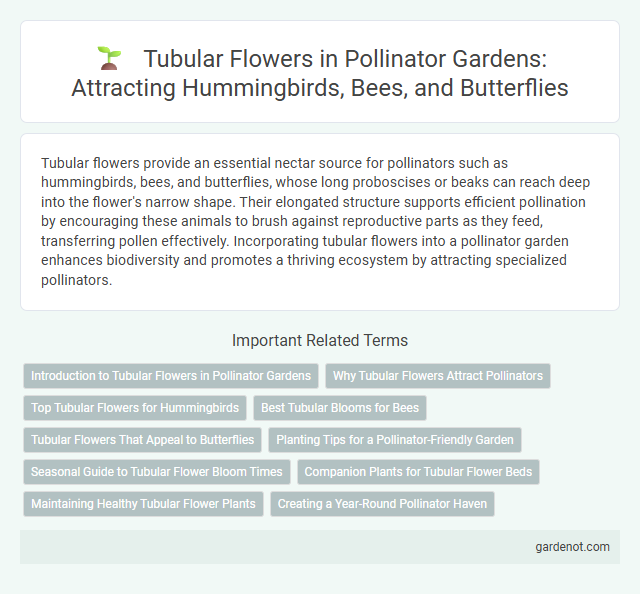Tubular flowers provide an essential nectar source for pollinators such as hummingbirds, bees, and butterflies, whose long proboscises or beaks can reach deep into the flower's narrow shape. Their elongated structure supports efficient pollination by encouraging these animals to brush against reproductive parts as they feed, transferring pollen effectively. Incorporating tubular flowers into a pollinator garden enhances biodiversity and promotes a thriving ecosystem by attracting specialized pollinators.
Introduction to Tubular Flowers in Pollinator Gardens
Tubular flowers play a crucial role in pollinator gardens by attracting specialized pollinators such as hummingbirds, butterflies, and certain bees that have long proboscises adapted to accessing nectar deep within the floral tube. These flowers often feature elongated corollas and vibrant colors, making them highly visible and accessible to pollinators that drive effective pollination and biodiversity. Incorporating species like salvia, foxglove, and honeysuckle can enhance the ecological health and aesthetic appeal of a pollinator garden.
Why Tubular Flowers Attract Pollinators
Tubular flowers attract pollinators by providing specialized shapes that accommodate the feeding habits of hummingbirds, butterflies, and certain bees, allowing them to efficiently access nectar deep within the blooms. Their elongated structure often matches the long proboscises of these pollinators, facilitating effective pollen transfer during feeding. This coevolutionary adaptation increases pollination success and supports biodiversity in pollinator gardens.
Top Tubular Flowers for Hummingbirds
Top tubular flowers for hummingbirds include trumpet vine, honeysuckle, and salvia, which provide rich nectar sources essential for their energy needs. These blossoms feature long, narrow shapes perfectly adapted to hummingbirds' slender beaks, enabling efficient feeding. Planting a variety of tubular flowers ensures continuous nectar availability and supports hummingbird pollination throughout the growing season.
Best Tubular Blooms for Bees
Tubular flowers such as bee balm, penstemon, and trumpet vine provide essential nectar and pollen resources for bees, supporting their foraging efficiency. These blossoms feature elongated corollas that fit the anatomy of long-tongued bees like bumblebees and honeybees, facilitating effective pollination. Incorporating a variety of tubular blooms in pollinator gardens boosts biodiversity and sustains pollinator populations throughout the growing season.
Tubular Flowers That Appeal to Butterflies
Tubular flowers such as butterfly bush (Buddleja), honeysuckle (Lonicera), and trumpet vine (Campsis radicans) are highly attractive to butterflies due to their elongated shapes that accommodate butterfly proboscises. These flowers provide rich nectar sources essential for energy, promoting prolonged butterfly visitation and pollination efficiency. Incorporating a variety of tubular flower species enhances biodiversity and supports local butterfly populations in pollinator gardens.
Planting Tips for a Pollinator-Friendly Garden
Choose tubular flowers such as trumpet honeysuckle, penstemon, and salvia to attract hummingbirds and long-tongued bees to your pollinator garden. Plant these flowers in clusters within well-drained soil and ensure they receive at least six hours of sunlight daily for optimal growth and nectar production. Incorporate native species to support local pollinators and avoid pesticides to maintain a healthy, thriving ecosystem.
Seasonal Guide to Tubular Flower Bloom Times
Tubular flowers such as trumpet vine, honeysuckle, and penstemon offer essential nectar sources for pollinators, blooming from early spring through late fall in temperate regions. Early-season tubular flowers like columbine and honeysuckle emerge in spring, attracting hummingbirds and bees when food is scarce. Mid to late summer varieties like trumpet vine and penstemon extend nectar availability, supporting pollinators throughout the growing season.
Companion Plants for Tubular Flower Beds
Companion plants for tubular flower beds include milkweed, salvia, and bee balm, which attract pollinators such as hummingbirds and bees. These plants improve pollination efficiency by providing a diverse range of nectar sources and complementary bloom times. Strategically combining tubular flowers with companion species enhances garden biodiversity and supports a robust pollinator ecosystem.
Maintaining Healthy Tubular Flower Plants
Maintaining healthy tubular flower plants requires regular watering, ensuring well-drained soil, and providing adequate sunlight for optimal growth. Pruning spent blooms encourages continuous flowering and reduces the risk of disease. Applying balanced fertilizer during the growing season supports vibrant blooms and attracts pollinators such as hummingbirds and bees.
Creating a Year-Round Pollinator Haven
Tubular flowers, such as trumpet honeysuckle and penstemon, offer deep nectar sources that attract hummingbirds, bees, and butterflies throughout the year. Incorporating a variety of tubular blooms with staggered flowering seasons ensures continuous food supply for pollinators. Strategic planting of these vibrant flowers in a pollinator garden supports biodiversity and enhances ecosystem resilience across all seasons.
Tubular flower Infographic

 gardenot.com
gardenot.com